Fibrocystic breast disease, commonly just referred to as fibrocystic breasts, represents a benign condition many women experience. Characterized by lumpy, sometimes painful breast tissue, these changes are often associated with a woman’s menstrual cycle and can fluctuate accordingly. Recognizing fibrocystic breasts may initially cause concern due to the presence of lumps; however, it’s noteworthy that this condition is non-cancerous and highly common among women of various ages.
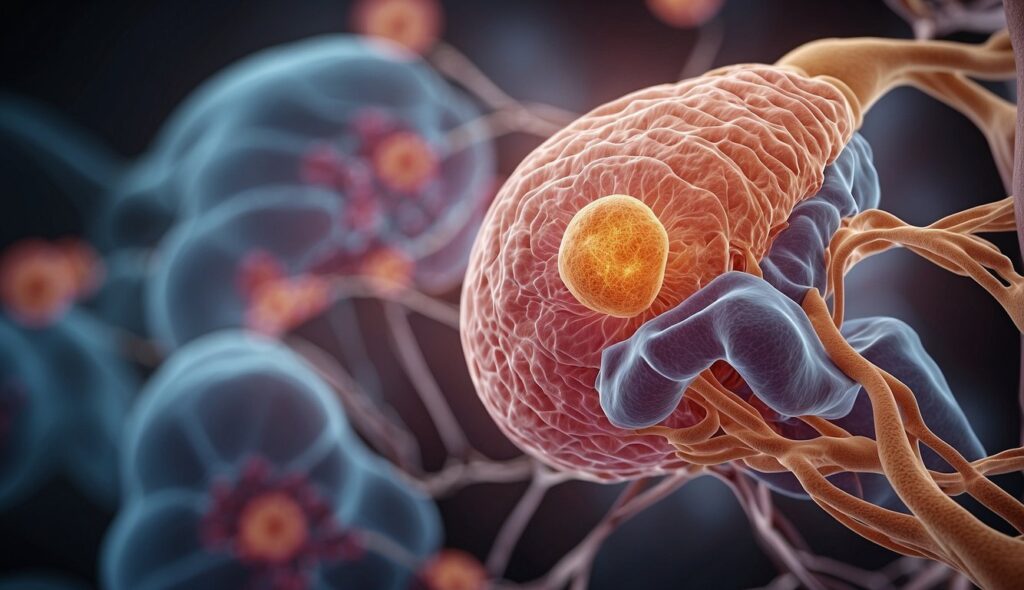
Understanding your body’s changes is essential for maintaining breast health. Should you find yourself experiencing symptoms such as breast pain, tenderness, or lumps particularly before menstruation, it may be a manifestation of fibrocystic changes. It’s important to consult with healthcare professionals to properly diagnose this condition while ruling out other potential concerns. Managing the symptoms often involves lifestyle modifications and, occasionally, medical intervention to alleviate discomfort, ensuring that the quality of life is not compromised.
Key Takeaways
- Fibrocystic breasts are a benign and common condition manifesting with lumpy and often tender breast tissue.
- Proper diagnosis involves healthcare consultation to distinguish the changes from other breast conditions.
- Symptoms management may include lifestyle adjustments and medical therapies to maintain comfort and breast health.
Understanding Fibrocystic Breast Disease
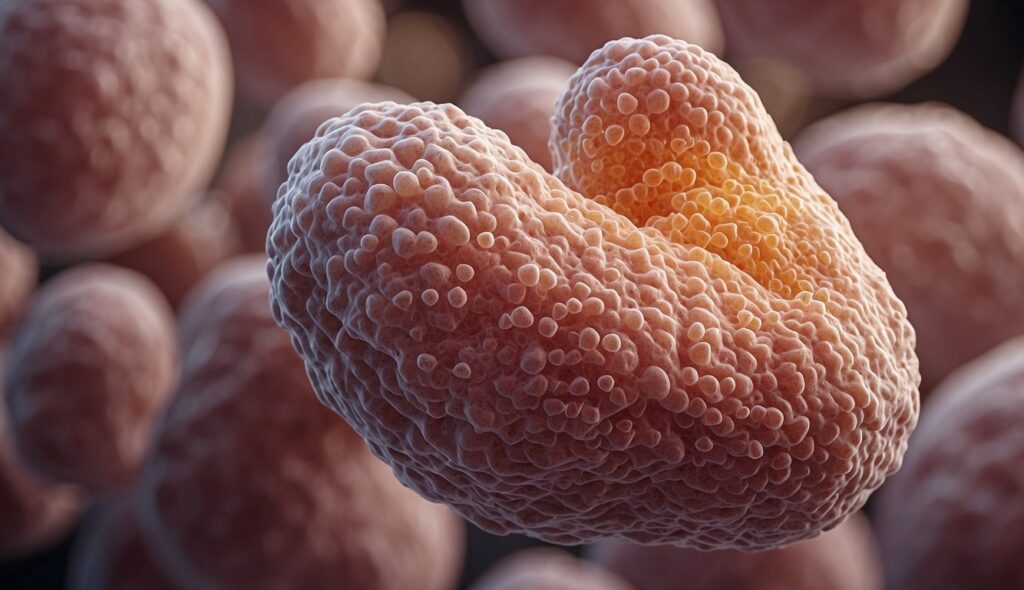
Fibrocystic Breast Disease, also known as fibrocystic breasts, denotes a range of breast changes that are non-cancerous (benign) in nature. Understanding this common condition can help you identify symptoms and appreciate its prevalence.
Definition and Overview
Fibrocystic Breast Disease refers to a benign condition characterized by lumpy or ropelike breast tissue. These changes are the result of fluctuating hormones and are composed of nodular and glandular tissues. While the term “disease” may sound alarming, it’s important to note that it’s not necessarily associated with breast cancer. Your breasts might feel tender, and there can be cysts or fibrosis, which are non-cancerous fibrous tissues.
Prevalence
Fibrocystic breast changes are quite common, particularly in women who are premenopausal, typically between the ages of 20 and 50. It is estimated that around 50% of women in this age group will experience fibrocystic changes at some point. However, it is rare in postmenopausal women not taking hormonal replacement therapy. These changes can fluctuate during the menstrual cycle, often becoming more noticeable just before your period.
Symptoms and Diagnosis
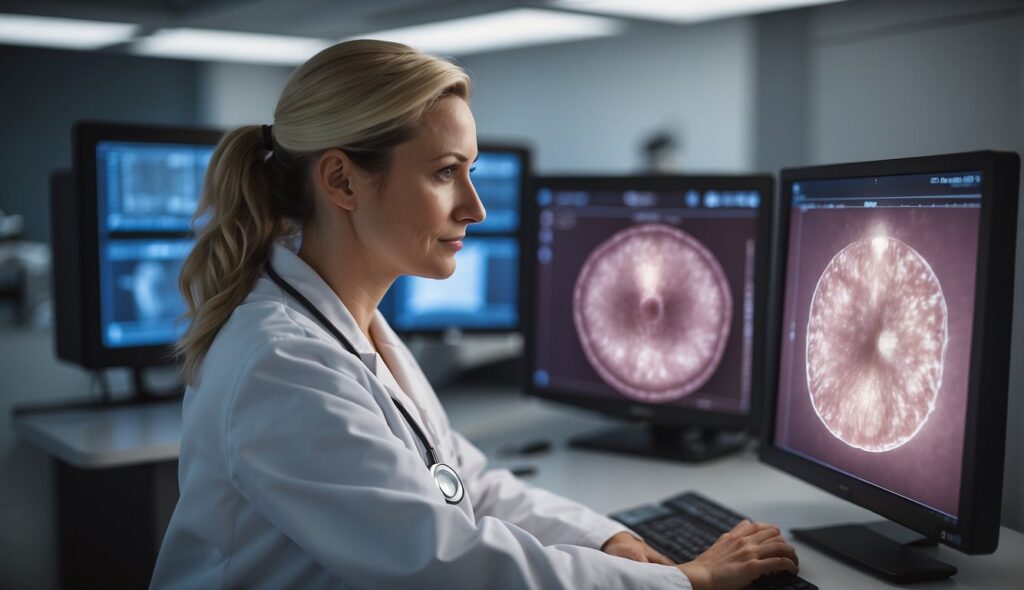
This section will help you understand the typical symptoms associated with fibrocystic breast disease and the diagnostic processes used to confirm a diagnosis.
Identifying Common Symptoms
You may notice symptoms of fibrocystic breast disease as lumps, pain, and tenderness in your breasts. These symptoms can be more pronounced during your menstruation cycle. The breasts may feel swollen or exhibit a thickening of tissue. Some women experience nipple discharge that is not related to lactation, and these symptoms can range from mild to painful.
- Lumps: These can feel rubbery and mobile.
- Pain and Tenderness: Often cyclical, peaking before menstruation.
- Swollen Tissues: Can occur in one or both breasts.
Diagnostic Procedures
When it comes to diagnosis, healthcare providers start with a breast exam to feel for cystic changes or breast lumps.
- Mammogram: A specialized type of mammography that can highlight areas of concern.
- Ultrasound: Used to differentiate solid from cystic breast lumps.
- Biopsy: May be recommended if suspicious lumps are present to assess for malignancy.
If there are prominent lumps or other concerns during a breast exam, a diagnostic mammogram or ultrasound may be ordered. A biopsy is sometimes necessary to obtain tissue samples, but not all lumps or cystic changes require one.
Mayo Clinic provides a comprehensive overview of the diagnostic methods. For a broader context around fibrocystic breast disease and ultrasound application, you can refer to StatPearls.
Causes and Risk Factors
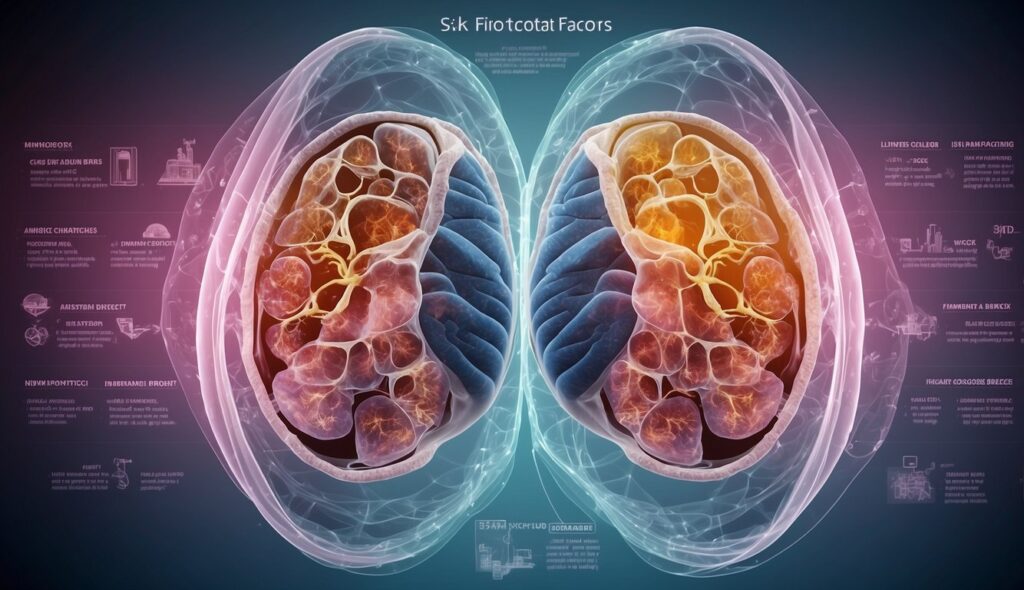
Understanding why you might experience fibrocystic breast changes involves looking at the hormonal and lifestyle-related influences that contribute to this condition.
Hormonal Influences
Your breasts are impacted by fluctuations in reproductive hormones. Specifically, estrogen and other hormones play a significant role in the texture and composition of your breast tissue during the menstrual cycle. These hormonal shifts can cause your breast tissue to feel lumpy or rope-like.
- Estrogen: High levels of this hormone can lead to an increase in fibrous tissue, making breasts feel denser.
- Menstrual Cycle: Changes in breast consistency often occur during different phases, typically worsening before menstruation and improving afterward.
Lifestyle and Environmental Factors
Your daily habits and environment can also influence fibrocystic breast changes. Some studies suggest that consuming caffeine may exacerbate symptoms, although this link is still under debate.
- Diet: Consider monitoring your intake of food and beverages with caffeine to see if your symptoms change.
- Environment: Exposure to certain substances or lifestyle-related stressors may also play a role, though more research is needed to clarify these connections.
By understanding these factors, you can better manage and anticipate the changes in your breast tissue.
Pathophysiology
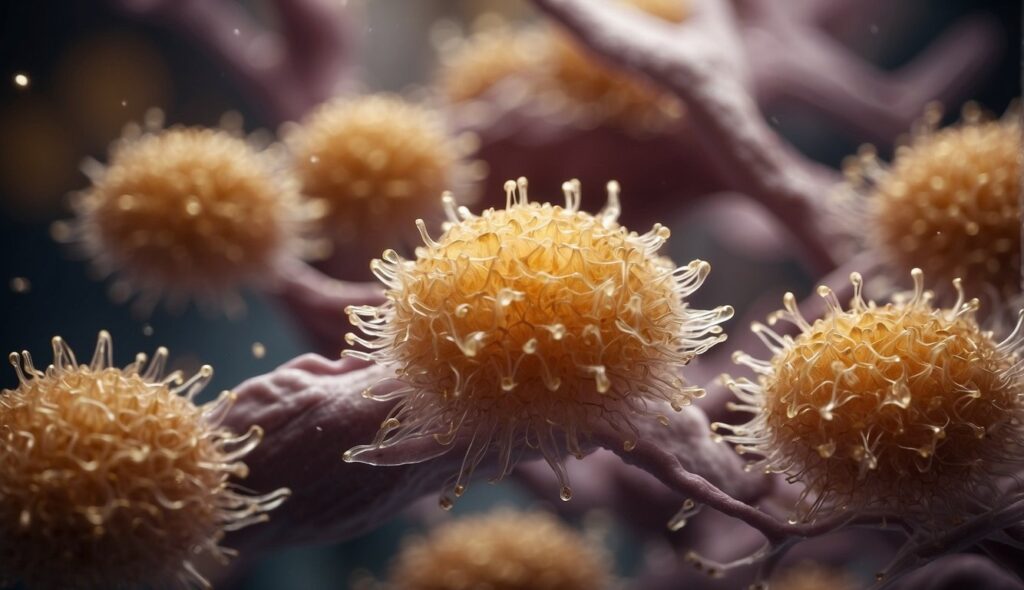
Understanding the pathophysiology of fibrocystic breast changes is key to recognizing how your breast tissue is affected. These changes can lead to the development of cysts and areas of hyperplasia that may produce discomfort.
Breast Tissue Changes
Your breast tissue is composed of a mixture of lobules (milk-producing glands), ducts (tubular structures that carry milk to the nipple), and fatty and fibrous connective tissues. Fibrocystic breast changes often refer to a variety of conditions characterized by fibrosis and the formation of cysts, which are fluid-filled sacs. Moreover, adenosis, an increase in the number of lobules, can also be part of these changes.
Here is how the changes can manifest:
- Fibrosis: Thickening and scarring of connective tissue
- Cysts: Non-cancerous, fluid-filled sacs
- Adenosis: Enlargement of the breast lobules
Cysts and Hyperplasia
Cysts may vary in size and often fluctuate with your menstrual cycle, becoming more pronounced or tender during certain times. Hyperplasia, on the other hand, involves an overgrowth of cells lining your breasts’ ducts or lobules. While typically benign, certain forms of hyperplasia, such as atypical hyperplasia, can increase your risk of developing breast cancer.
To encapsulate:
- Cysts: Can change in size and may be tender periodically
- Hyperplasia: Overgrowth of cells that can be a benign condition or, less commonly, associated with a higher risk of breast cancer
Correlation with Breast Cancer

Understanding the relationship between fibrocystic breast changes and breast cancer is crucial because while the former is a benign condition, vigilance is necessary to differentiate these benign changes from potential malignancies.
Differentiating Benign Changes
Fibrocystic breast changes are a benign breast disease affecting many women and are characterized by lumpy or ropelike breast tissue. These changes are distinct from breast cancer, which manifests as uncontrolled cell growth forming tumors. According to the American Cancer Society, recognizing the differences between fibrocystic changes like tenderness or cysts and the presence of tumors is essential in early detection and appropriate management of breast health.
Monitoring and Vigilance
The U.S. Preventive Services Task Force recommends regular breast cancer screenings, as early detection significantly improves outcomes. Even though fibrocystic breast changes are not cancer, your healthcare provider may recommend monitoring through clinical breast exams and mammography. These imaging techniques allow for close observation of breast tissue over time to quickly address any suspicious changes that could indicate cancer.
Management of Symptoms

To address the discomfort associated with Fibrocystic Breast Disease, both medical treatments and self-care strategies can be effective. It’s important to consider these options to manage symptoms such as breast pain.
Medical Treatments
For breast pain that disrupts daily life, over-the-counter pain relievers like acetaminophen or ibuprofen can offer relief. Medications such as Tylenol may reduce discomfort, but you should follow the recommended dosage and consider any potential side effects.
Self-Care and Lifestyle Adjustments
In addition to medical treatments, implementing self-care measures can make a significant difference in managing symptoms. These include:
- Breast self-awareness: Becoming familiar with the normal texture and appearance of your breasts may help you detect changes or identify pain triggers.
- Diet: Adopting a low-fat diet and including more fruits, vegetables, and whole grains can improve overall health and potentially reduce breast pain.
- Supportive garments: Wearing a well-fitted, supportive bra, especially during exercise, can minimize breast movement and related pain.
Therapeutic Interventions

When managing Fibrocystic Breast Disease, your options span from pharmacological treatments to potential surgical interventions, focusing on alleviating symptoms and addressing tissue changes.
Pharmacological Options
Medications can offer significant relief. Over-the-counter pain relievers, such as ibuprofen or acetaminophen, may alleviate discomfort. In some cases, your doctor might recommend hormone therapy using birth control pills to regulate your menstrual cycle and reduce breast tenderness. Other prescribed treatments could include progesterone creams or tamoxifen, particularly if your symptoms are severe. However, these medications can come with side effects, ranging from weight gain to a higher risk of blood clots, which should be discussed with your healthcare provider.
Danazol is another prescription option, although it’s used less frequently due to its androgen-like effects. The choice of medicine will depend on your specific symptoms, medical history, and the presence of other health conditions.
Surgical Considerations
Surgical options are generally considered when persistent breast lumps do not respond to other treatments or when there is uncertainty about whether a lump is benign or malignant. Procedures like fine-needle aspiration can help diagnose and sometimes treat lumps by removing fluid from cysts. In more complex cases, biopsies are performed to extract tissue samples for further examination.
Surgery is rarely required for Fibrocystic Breast Disease; it’s reserved for atypical hyperplasia or when there’s considerable concern about the presence of cancer. If surgery becomes necessary, your surgeon will discuss the types of procedures, potential risks, and what you can expect in terms of recovery and outcomes.
Guidelines for Breast Health

Maintaining breast health is essential, and both healthcare providers and organizations like the Mayo Clinic provide specific guidelines. These combine regular clinical recommendations with the practice of breast self-exams to promote early detection of any changes.
Clinical Recommendations
Your healthcare provider can offer personalized guidance for breast health, but general recommendations include annual clinical breast exams if you are over the age of 40. According to the American Cancer Society, these exams are crucial for detecting breast conditions early, when they are most treatable. During these exams, your doctor will check for any abnormalities, including areas where the breasts feel lumpy which might indicate fibrocystic breast changes or other benign conditions.
Breast Self-Examination
Performing regular breast self-exams is a proactive way to monitor your breast health. The Mayo Clinic endorses monthly self-exams as a familiarization process to understand the normal composition of your breasts. Here’s a brief step-by-step:
Visual Inspection: Stand in front of a mirror with your shoulders straight and arms on your hips. Look for any changes in contour, swelling, dimpling of the skin, or changes in the nipples.
Physical Examination: Use the pads of your fingers to feel your breasts while lying down and standing up. Cover the entire breast from top to bottom, side to side.
When to perform:
- Timing: Best done several days after your period ends, when your breasts are least likely to be swollen or tender.
- Frequency: Monthly.
If you detect any unusual changes in your breasts, report them to your healthcare provider for further evaluation. Remember, these self-exams are not a replacement for regular screenings but a supplementary practice to boost your breast health awareness.
Living with Fibrocystic Changes
Fibrocystic changes, involving lumpiness and soreness in your breast tissue, can affect your daily life and emotional well-being. It’s important to understand the emotional effects these changes can have and the strategies you can employ to manage them.
Emotional and Psychological Impacts
Living with fibrocystic changes can lead to a range of emotional responses as you may notice your breasts feeling lumpy or experiencing swell and soreness. This can sometimes cause anxiety, especially when you’re unsure if the changes are benign. After menopause, you might observe a decrease in these symptoms; however, if you’re on hormone replacement therapy, these changes may persist. It’s common to feel concern if you notice puckering of the skin or other changes in the breast’s appearance.
Coping Strategies
To handle the physical discomfort and maintain your quality of life, consider these strategies:
- Make sure you wear supportive bras, especially during exercise, to minimize discomfort from breast movement.
- Apply warm or cold compresses to your breasts to soothe soreness.
- Limit intake of caffeine and high-fat foods, which some women find helpful in reducing breast pain and swelling.
- Engage in regular, moderate exercise to help manage stress and promote overall well-being.
- Keep regular appointments with your healthcare provider to monitor fibrocystic changes and to distinguish normal lumpiness from more serious conditions.
Practicing self-care and staying informed about your condition can help you navigate living with fibrocystic changes with confidence.
Recent Advances and Research
Research in the realm of Fibrocystic Breast Disease (FBD) is continuously evolving, providing you with innovative diagnostic tools and promising therapeutic avenues. Your understanding of these developments can drastically improve how FBD is managed and treated.
Innovations in Imaging
Research has propelled advancements in breast imaging technologies. For instance, the role of breast ultrasound has been reaffirmed in distinguishing fibrocystic changes from malignancies. Notably, imaging techniques, such as Automated Breast Ultrasound (ABUS) and 3D mammograms, have improved the evaluation of dense breast tissue common in FBD. These methods enhance detection rates and reduce the likelihood of false positives, offering you a more precise diagnosis.
Future Directions in Treatment
In treatment, investigators are pioneering approaches that aim to address hormonal imbalance, which plays a key role in the manifestation of fibrocystic changes. Whether through pharmacological advancements or lifestyle modifications, your options may soon expand beyond the current regimen. Furthermore, ongoing studies are scrutinizing the link between FBD and mastitis, exploring whether targeted treatments for inflammation can also relieve fibrocystic symptoms, thereby optimizing your quality of life.
Resources and Support
When managing fibrocystic breast changes, accessing the right resources and support can significantly enhance your understanding and comfort. Utilizing expert-backed information and connecting with others can provide reassurance and practical tips for coping with symptoms influenced by hormonal changes.
Organizations and Information
Organizations:
- Mayo Clinic: You can find reliable information on managing symptoms and when to seek treatment for fibrocystic breasts on Mayo Clinic’s website.
- NCBI Bookshelf: For in-depth medical insights about fibrocystic breast changes and reproductive hormones, refer to NCBI’s Bookshelf.
Comprehensive Guides:
- Breast Health Factsheets: Obtain thorough guides and Q&A resources, such as the PDF on fibrocystic breast changes and their relation to female hormones.
Healthcare Advice:
- Your own healthcare provider is a crucial resource for personalized advice on breast health and hormonal changes linked to your situation.
Support Networks and Groups
Local and Online Communities:
- Engage with support networks where you can share experiences and tips with others who understand the nuances of managing fibrocystic breast conditions.
Product Recommendations:
- Discussions often cover wearables like supportive and sports bras that can alleviate discomfort during various activities.
Hormonal Management Tips:
- Learn from others how to track and respond to your body’s reproductive hormones and the resulting breast changes throughout your menstrual cycle.
Remember, while online communities are great for sharing experiences, always verify medical advice with your healthcare provider.
Frequently Asked Questions
In this section, you’ll find concise answers to some of the most common questions related to fibrocystic breast condition, including treatments, dietary considerations, and management strategies.
What are common treatments for fibrocystic breast condition?
For managing fibrocystic breast changes, treatments often focus on symptom relief. Over-the-counter pain relievers, such as ibuprofen or acetaminophen, can alleviate discomfort. Some find that wearing a supportive bra also helps reduce breast pain.
Is there a link between diet and fibrocystic breast discomfort?
Yes, dietary choices may affect fibrocystic breast discomfort. Caffeine reduction, maintaining a low-fat diet, and avoiding high-sodium foods are commonly suggested. However, it’s essential to evaluate how your own body responds to these dietary adjustments.
How can fibrocystic breast symptoms be differentiated from breast cancer symptoms?
Fibrocystic breast symptoms typically include lumpiness, tenderness, and pain that fluctuate with your menstrual cycle. Breast cancer symptoms often involve a painless, immovable lump, skin dimpling, or nipple retraction. Regular clinical exams and mammograms are crucial for accurate diagnosis.
Is fibrocystic breast condition likely to occur in one breast or both?
Fibrocystic breast condition commonly affects both breasts, but it can occur in just one. The changes, like lumpiness or pain, may not be symmetrical; one breast may feel different than the other.
Are there specific vitamins or supplements recommended for those with fibrocystic breasts?
Some believe that vitamin E and vitamin B6 supplements may help alleviate the symptoms associated with fibrocystic breasts. However, you should consult with a healthcare provider before starting any new supplements.
What lifestyle changes can help manage fibrocystic breast disease?
Lifestyle changes like reducing the intake of caffeine and fat, ensuring adequate support with well-fitting bras, and applying heat or ice packs to the breasts may provide relief. Regular exercise and stress reduction techniques can also be beneficial in managing symptoms.